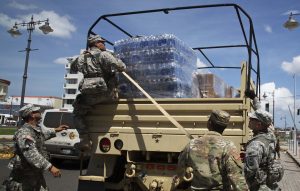Data and water scientists aim to learn from an unparalleled natural disaster.
Among the many problems faced by residents of Puerto Rico in the aftermath of Hurricane Maria is a lack of clean drinking water; this poses health risks for people who have already endured unprecedented hardship.
The storm and its aftermath also provided a distinctive occasion for an interdisciplinary research team, including RENCI experts, to collect data to understand how the storm impaired the island’s water resources. Through a grant from the National Science Foundation (NSF), the team is developing a software system to archive and share information about drinking water quality in some of the most devastated areas of Puerto Rico, and assessing how disruption in services affects water quality and relates to disease outbreaks.
“Maria’s effects on the island and its residents presents a unique opportunity to gain new insight into the complexity of disasters of this scale,” said RENCI Senior Earth Data Scientist Chris Lenhardt. “This project is an interdisciplinary, multi-institutional effort to collect data, use it strategically to help Puerto Rico, and archive it for use in future research.”
Led by Research Scientist Christina Bandaragoda, PhD, of the University of Washington’s Department of Civil and Environmental Engineering, the project will first assess the presence of waterborne pathogens in public water systems impacted by the hurricane—some of which are still cut off from the electrical grid. Researchers from Virginia Tech and the Interamerican University of Puerto Rico have designed a drinking water campaign to assess a cross section of utilities, communities, and the surface water quality along a stream network.
“Recovery efforts from natural disasters can be more efficient with data-driven information on current needs and future risks,” said project Principal Investigator, Bandaragoda, “We are researching how to improve the infrastructure that provides this information, with a focus on drinking water data.”
That data will be “wrangled” with help from RENCI. Data objects will be defined, different conventions across disciplines—from nomenclature to scales and formats—will be rationalized so that different datasets can be integrated and compared, and metadata tags will be assigned to make the data more easily discoverable and connect it with a location and time of collection. The water samples will be compared to data about human health, localized disease outbreaks, and repositories of clinical data, a process that requires anonymization to protect confidentiality.
“This data can be used to examine many questions related to water quality and sanitation and the relationship between disruptions in the system and the spread of waterborne diseases,” said Lenhardt. “That means researchers must be able to use it across different disciplines. We are leveraging our expertise in data management and cyberinfrastructure best practices to make the data as usable as possible as quickly as possible.”
While the data could help public health experts, government officials and researchers understand immediate problems in Puerto Rico, it also has long-term value for scientists. To make the datasets available and usable by the larger scientific community, they will be uploaded to HydroShare, an open source, collaborative system for sharing hydrologic data and models. HydroShare is part of the data sharing capabilities offered by the Consortium of Universities for the Advancement of Hydrologic Science, Inc. (CUAHSI), a nonprofit research organization that represents more than 100 universities and international water science organizations.
For nearly six years, RENCI researchers, under the direction of DevOps Director Ray Idaszak, have co-led the effort to develop the HydroShare architecture, which includes hydrologic datasets, software for storage and computation, web services, and a variety of applications. HydroShare, also funded by the NSF with Dave Tarboton of Utah State University as the lead principal investigator, initially focused on making hydrologic datasets and models easily discoverable and sharable. With a second round of funding last year, the project has focused more closely on providing tools and applications to run hydrologic models and analyze data.
Making the Hurricane Maria water quality and related storm and environmental data available through HydroShare will be a first step in creating an integrated cyberinfrastructure of models, applications, and datasets that scientists will be able to use to understand how major storms and natural disasters can impact water quality, and how compromised water quality relates to disease outbreaks and overall human health.
For more information on this project:
University of Washington: RAPID grant awarded for Puerto Rico research
GitHub: Puerto Rico Water Studies Wiki



